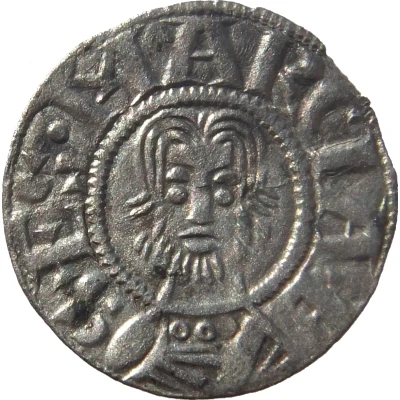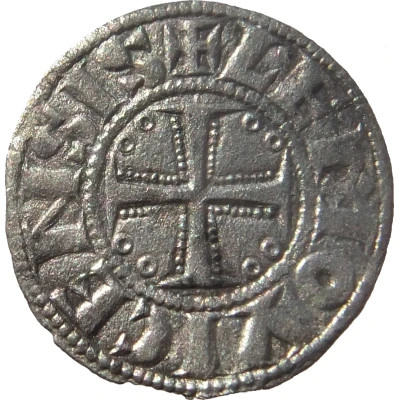


Denier anonymous ND
| Billon | 0.91 g | 19.5 mm |
| Issuer | Abbey of Saint Martial (French States) |
|---|---|
| Type | Standard circulation coin |
| Years | 1106-1245 |
| Value | 1 Denier (1⁄240) |
| Currency | Livre |
| Composition | Billon |
| Weight | 0.91 g |
| Diameter | 19.5 mm |
| Shape | Round (irregular) |
| Technique | Hammered |
| Orientation | Variable alignment ↺ |
| Demonetized | Yes |
| Updated | 2024-10-04 |
| Numista | N#56139 |
|---|---|
| Rarity index | 83% |
Reverse
Cross with 4 pairs of dots within an inner circle, legend around.
Script: Latin
Lettering: ✠ LEMOVICENSIS
Unabridged legend: Lemovicensis
Translation: [Denier] of Limoges.
Comment
Variant with crossed "L":
Mentioned for the first time in a document dated 1106 (cf. Henri Hugon, p. 80-93), the denarius of the abbey of Saint-Martial de Limoges is inspired by that of the priory of Souvigny in Bourbonnais, which appeared between 1095 and 1098 and features the bust of the beardless Saint Mayeul. It differs in particular by the beard worn by Saint Martial, from which it logically derives its name "barbarin" ("Lemovicensis barbata moneta" = "Limoges currency with a beard"). This denarius enjoyed great credit and was minted until around 1245.
On the right, the "E" in "SES" is in fact a square C, with the vertical bar crossed out horizontally to form a cross and thus abbreviate the word. This type of abbreviation is also found, among others, on the denarii of the bishopric of Clermont, which also feature a frontal bust.
Three groups of barbarine denarii can be identified from the various treasures unearthed: denarii with the legend SES MARCIAL, those with the legend S MARTIAL and those with the cross cantoned by various symbols (star and G in particular). The G barbarin is attributed to Viscount Gui V (1199-1230), who had barbarins minted at his château in Aixe-sur-Vienne in 1211.
There are many varieties: on the right, the effigy of the saint (face more or less elongated, position of hair, length of beard), the width of the bust, accosted or not, etc. On the reverse, the simple or beaded cross, with different combinations in the number and positioning of the canting rings.
Limousin finds containing Saint-Martial coins:
- Argentat (19): the largest with 1960 barbarins;
- Peyrat-le-Château (87): composed entirely of barbarins (1500);
- Droux (87);
- Folles (87): 88 barbarians;
- Montheil (87): 88 barbarians;
- Nontron (24): 469 barbarians;
- Nedde (87) etc...
Interesting fact
The coin is quite rare and valuable, with only a few known examples existing in collections today. One interesting fact about this coin is that it was minted during a time of great turmoil in Europe, when the Crusades were taking place and the Catholic Church was exerting significant influence over the political and economic landscape. Despite the challenges of the time, the Abbey of Saint Martial was able to produce this coin, which is a testament to the resilience and resourcefulness of the people who lived and worked there.